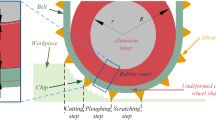Abstract
Real time simulation and visualization are important for robot programmers to verify and optimize the path planning for the robotic belt grinding process. A new free-form surface representation based on discrete surfel element is developed to facilitate the system implementation, which exploits the advantage of the new development of point-based rendering technology in computer graphics. A local process model is integrated to calculate the material removal rate by considering the local geometry information and non-uniform force distribution. The final surface grinding error is easy to be assessed and visualized for quality evaluation. The experiments show that the simulation error is below 15%, even for a non-uniform contact under stable cutting conditions.
Similar content being viewed by others
References
Kurfess TR (2001) Computer-aided design, engineering, and manufacturing: systems techniques and applications, volume VI, manufacturing systems processes, chapter production of high quality parts by the process of grinding in manufacturing systems. CRC Press
Law SS, Wu SM (1973) Simualtion study of the grinding process. Trans ASME 972–978
Hammann G (1998) Modellierung des Abtragsverhaltens elastischer robotergefuehrter Schleifwerkzeuge. PhD thesis, University Stuttgart, Stuttgart
Kawashima Y, Itoh K, Ishida T, Nonaka S, Ejiri K (1991) A flexible quantitative method for nc machining veri-fication using a space-division based solid model. Vis Comput 7:149–157
Wang WP, Wang KK (1986) Geometric modeling for swept volume of moving solids. IEEE Comput Graph Appl 6(12):8–17
Van Hook T (1986) Real-time shaded nc milling display. In Proceedings of the 13th annual conference on Computer graphics and interactive techniques, pages 15–20. ACM Press
Huang Y, Oliver JH (1994) Nc milling error assessment and tool path correction. In Proceedings of the 21st annual conference on Computer graphics and interactive techniques, pages 287–294. ACM Press
Mueller H, Surmann T, Stautner M, Albersmann F, Klaus W (2003) Online sculpting and visualization of multi-dexel volumes. In Proceedings of the eighth ACM symposium on solid modeling and applications, pages 258–261. ACM Press
Saito T, Tokiichiro T (1991) NC machining with G-buffer method. In Proceedings of the 18th annual conference on Computer graphics and interactive techniques, pages 207–216. ACM Press
Jerard RB, Hussaini SZ, Drysdale RL, Schaudt B (1989) Approximate methods for simulation and verification of numerically controlled machining programs. Vis Comput 5:329–348
Ayasse J (2003) Discrete displacement fields: a versatile representation of geometry for simulation in computer-aided manufacturing. PhD thesis, University Dortmund, Dortmund
Glaeser G, Gröller E (1998) Efficient volumegeneration during the simulation of NC-milling. In: Hege H-C, Polthier K (eds) Mathematical visualization. Springer, Berlin Heidelberg New York, pp 89–106
Herman GT (1992) Discrete multidimensional jordan surfaces. CVGIP: graph. Models Image Process 54(6):507–515
Pfister H, Zwicker M, van Baar J, Gross M (2000) Surfels: surface elements as rendering primitives. In: Akeley K (ed) Siggraph 2000, Computer Graphics Proceedings, pages 335–342. ACM Press/ACM SIGGRAPH/Addison Wesley Longman
Zwicker M, Pfister H, van Baar J, Gross M (2001) Surface splatting. In: Fiume E (ed) SIGGRAPH 2001, Computer Graphics Proceedings, pages 371–378. ACM Press/ACM SIGGRAPH
Levoy M, Whitted T (1985) The use of points as a display primitive. Technical report, Computer Science Department, University of North Carolina at Chapel Hill, January
Rusinkiewicz S, Levoy M (2000) QSplat: a multiresolution point rendering system for large meshes. In: Akeley K (ed) Siggraph 2000, Computer Graphics Proceedings, pages 343–352. ACM Press/ACM SIGGRAPH/Addison Wesley Longman
Pauly M, Keiser R, Kobbelt LP, Gross M (2003) Shape modeling with point-sampled geometry. ACM Trans Graph 22(3):641–650
Blinn JF (1978) Simulation of wrinkled surfaces. In SIGGRAPH ’78: Proceedings of the 5th annual conference on Computer graphics and interactive techniques, pages 286–292, New York, NY, USA, ACM Press
Doggett M, Hirche J (2000) Adaptive view dependent tessellation of displacement maps. In HWWS ’00: Proceedings of the ACM SIGGRAPH/ EUROGRAPHICS workshop on Graphics hardware, pages 59–66, New York, NY, USA, ACM Press
Oliver MA, Webster R (1990) Kriging: a method of interpolation for geographical information system. Int J Geogr Inf Syst 4(3):313–332
Shepard D (1968) A two-dimensional interpolation function for irregularly-spaced data. In Proceedings of the 1968 23rd ACM national conference, pages 517–524, New York, NY, USA, ACM Press
Blum H, Suttmeier F-T (2000) An adaptive finite element discretisation for a simplified Signorini problem. Calcolo 37(2):65–77, June
Blum H, Schroeder A, Suttmeier F-T (2003) A posteriori error bounds for finite element schemes for a model friction problem. In Proc. of simulation-aided offline process design and optimization in manufacturing sculptured surfaces, Witten- Bommerholz, Germany
Cabaravdic M, Kuhlenkoetter B (2005) Bandschleifprozesse optimieren. mo Metalloberfläche 4:44–47
Author information
Authors and Affiliations
Corresponding author
Rights and permissions
About this article
Cite this article
Ren, X., Kuhlenkötter, B. Real-time simulation and visualization of robotic belt grinding processes. Int J Adv Manuf Technol 35, 1090–1099 (2008). https://doi.org/10.1007/s00170-006-0791-0
Received:
Accepted:
Published:
Issue Date:
DOI: https://doi.org/10.1007/s00170-006-0791-0




